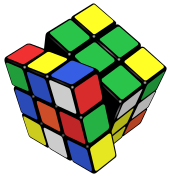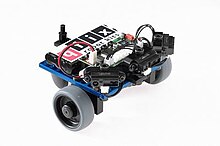Toy
Examples include children building a fort with empty cereal boxes and tissue paper spools, or a toddler playing with a broken TV remote.The origin of toys is prehistoric; dolls representing infants, animals, and soldiers, as well as representations of tools used by adults, are readily found at archaeological sites.Younger children use toys to discover their identity, help with cognition, learn cause and effect, explore relationships, become stronger physically, and practice skills needed in adulthood.Adults on occasion use toys to form and strengthen social bonds, teach, help in therapy, and to remember and reinforce lessons from their youth.One of the earliest examples of children's toys is a set of three stone balls found in the tomb of a four-year-old girl at Xi'an Banpo Neolithic site.Thousands of years ago, Egyptian children played with dolls that had wigs and movable limbs, which were made from stone, pottery, and wood.[11] In the nineteenth century, Western values prioritized toys with an educational purpose, such as puzzles, books, cards and board games.With growing prosperity among the middle class, children had more leisure time on their hands, which led to the application of industrial methods to the manufacture of toys.Carpenter and Westley began to mass-produce the kaleidoscope, invented by Sir David Brewster in 1817, and had sold over 200,000 items within three months in London and Paris.The company was also able to mass-produce magic lanterns for use in phantasmagoria and galanty shows, by developing a method of mass production using a copper plate printing process.During the late 18th and early 19th century, many families needed to send their children to work in factories and other sites to make ends meet—just as their predecessors had required their labor producing household goods in the medieval era.After trying to create a replacement for synthetic rubber, the American Earl L. Warrick inadvertently invented "nutty putty" during World War II.He spent two years fine-tuning the design to find the best gauge of steel and coil; the result was the Slinky, which went on to sell in stores throughout the United States.In modern times, there are computerized dolls that can recognize and identify objects, the voice of their owner, and choose among hundreds of pre-programmed phrases with which to respond.[24] The act of children's play with toys embodies the values set forth by the adults of their specific community, but through the lens of the child's perspective.In Saharan and North African cultures, play is facilitated by children through the use of toys to enact scenes recognizable in their community such as hunting and herding.In the Western culture, the Barbie and Action-Man represent lifelike figures but in an imaginative state out of reach from the society of these children and adults.Wooden blocks, though simple, are regarded by early childhood education experts such as Sally Cartwright (1974) as an excellent toy for young children; she praised the fact that they are relatively easy to engage with, can be used in repeatable and predictable ways, and are versatile and open-ended, allowing for a wide variety of developmentally appropriate play.[28] Andrew Witkin, director of marketing for Mega Brands, told Investor's Business Daily that "They help develop hand-eye coordination, math and science skills and also let kids be creative."[29] Other toys like marbles, jackstones, and balls serve similar functions in child development, allowing children to use their minds and bodies to learn about spatial relationships, cause and effect, and a wide range of other skills.[37] A variety of global toy companies have marketed themselves to this aspect of girls' development, for example, the Hello Kitty brand and the Disney Princess franchise.The researchers then quantified play quality of the children with each toy based on factors such as learning, problem solving, curiosity, creativity, imagination, and peer interaction.[49] A study done by researcher Susan Witt suggests that stereotypes are oftentimes only strengthened by the environment, which perpetuates them to linger in older life.[44] Researchers Carol Auster and Claire Mansbach have argued that allowing children to play with toys which more closely fit their talents would help them to better develop their skills.[46] Even as this debate is evolving and children are becoming more inclined to cross barriers in terms of gender with their toys, girls are typically more encouraged to do so than boys because of the societal value of masculinity.Other materials that are, or have been, used in the manufacture of dolls include cornhusks, bone, stone, wood, porcelain (sometimes called china), bisque, celluloid, wax, and even apples.A distinction is often made between dolls and action figures, which are generally of plastic or semi-metallic construction and poseable to some extent, and often are merchandising from television shows or films which feature the characters.Examples of the latter range from wooden sets for younger children such as BRIO to more complicated realistic train models like those produced by Lionel, Doepke and Hornby.The concept of using technology in a way that bridges the digital with the physical world, providing unique interactive experiences for the user, has also been referred to as phygital.Countries or trade zones such as the European Union regularly publish lists to regulate the quantities or ban chemicals from toys and juvenile products.

















Toy (disambiguation)Toymaker (disambiguation)entertainmenttoy blocksboard gamesinteractive digital entertainmentsmart toysprehistoriccognitionAncient GreekKerameikosIndus valley civilizationEgyptianancient Greeceancient Rometerracottabows and arrowsyo-yosrite of passagemechanical puzzleEnlightenmentMedievalJean-Baptiste-Siméon Chardintoy wagonsspinning wheelspuppetsJohn JefferysteetotumNoah's Arkmiddle classleisureopticalCarpenter and WestleykaleidoscopeDavid Brewstermagic lanternsphantasmagoriamass productionroyaltyzoetropeWilliam George Hornerporcelaindoll housesMeccanoIndustrial EraReal wagesFranz KolbplasticineFrank Hornbyengineering principlesHornby Model RailwaysDinky Toysgirdersdie-cast toysBritains companytoy soldiershollow castingTangramThe Tale of Peter RabbitBeatrix PotterPeter Rabbitsoft toyPatent OfficeSmithsonianMickey MouseHarry PotterSecond World Warsynthetic rubberEarl L. WarrickWorld War IISilly PuttyPlay-DohRichard JamesSlinkyname-brandHilary PageKiddicraftV&A Museum of ChildhoodMr. Potato HeadBarbie dollBild Lilli dollAction ManRubik's CubeSaharanNorth Africanhorse and cartcognitive behaviorblocksMega BrandsInvestor's Business Dailymarblesjackstonesspatial relationshipscause and effectpaddle ballsChinese artistSong dynastyWellesley Collegephysical developmentcognitive developmentsocial developmenttexturesEducational toyspuzzleNewton's cradleSimon Prebbleconservation of momentum and energyHello KittyDisney PrincessGirls' toys and gamesBoys' toys and gamesBarbieSex Rolesmeta-analysisNature and nurturegender rolesTargetIndigenous South AmericanDigby, Nova ScotiaSaint Nicholas DayThree Kings DayToys "R" UsMattelPearl River DeltaGuangdong Provincevideo game